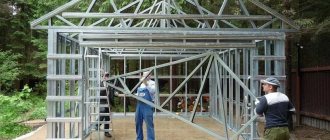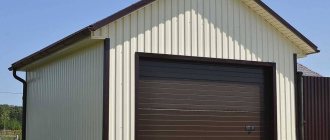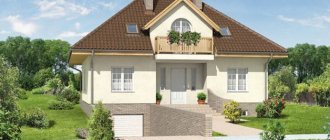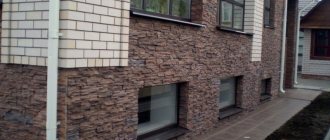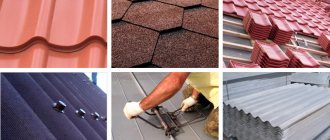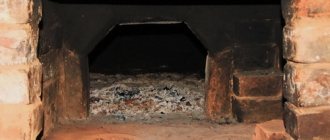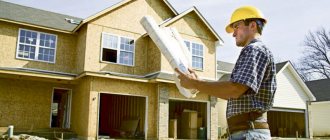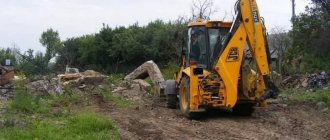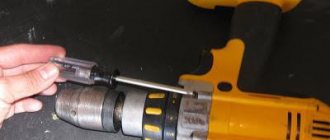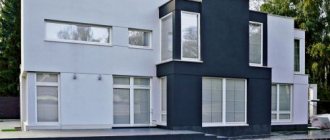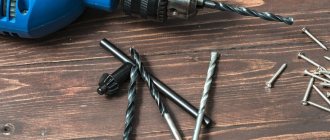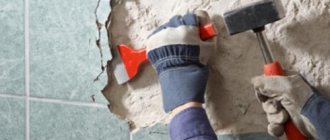Topics devoted to the construction of garages, greenhouses and outbuildings traditionally arouse increased interest among FORUMHOUSE users. This is reflected in the demand for such objects on the site and the possibility of their independent construction at a reasonable price. Many people start building a large house with small architectural forms - you can improve your skills and test your strength.
Our portal has already told you how to build a budget and functional shed. In today’s material we will tell you how to build a frame garage on wooden poles with your own hands using the example of a step-by-step description of the story of a portal participant with the nickname Alano.
Garage made of foam blocks
I chose this building material because cellular concrete is cheap, lasts a long time and retains temperature well. Foam blocks are lightweight, construction is fast.
Advantages of foam blocks
- Fire resistance.
- Cheap, especially if you build it yourself.
- Environmental friendliness. The building material consists of sand, cement and water.
- The blocks can be cut with an ordinary saw, plastered, painted and glued.
- The walls are smooth without adjustment or plastering, although the garage can be lined if desired.
- The blocks can be connected without cement. If you are not sure that you can handle professional masonry, you can use special glue.
Cost calculation
Garages almost do not differ in size and architectural features, but you still have to make calculations of the amount of building material:
- Wall area. Multiply the height of the wall by the length and add the results. There will be a garage door on the front wall, this should be taken into account when calculating the total area.
- Wall thickness. Usually from 20 to 40 cm.
- Block density.
For example, let's take a building with parameters of 5 m - long walls, 3 m - end walls and 2 m - height. We will not take into account the area of the gate for now, but then we need to subtract it.
After simple calculations we get:
- The area of two long walls is 20 square meters. m
- The area of the short walls is 12 square meters. m.
- The total area is 32 square meters. m.
- If the side size of the block is 200 * 600 mm, each of them is 0.12 square meters. m.
- This means you need to buy 266 blocks (32 sq.m / 0.12 sq.m)
You will have to spend money not only on the construction of walls, the price of foam blocks will be only about 35% of the total investment. You should also take into account the costs of the foundation, floor, roof, and gates.
Need to purchase
- Sand for the foundation and floor - 5 m3 for 800 rubles. = 4,000 rub.
- Concrete M 200 - 5 m3 for 3500 rubles. = 17,500 rub.
- Bitumen mastic - 15 kg - 700 rub.
- Solution M100 for 2,400 rubles. — 5,520 rub.
- Fittings - 4,000 rub.
- Two rolls of masonry mesh, 15 square meters each. m = 6,800 rub.
- Foam blocks 20×30×60 cm (266 pieces for 150 rub.) = 39,900 rub.
- Boards 1.5 m3 for 5,000 rubles. = 7,500 rub.
- Beams 1 m3×5,000 rub. = 5,000 rub.
- Mineral wool for flooring - 1.5 m3 for 4,300 rubles. = 6,450 rub.
- Roofing material (metal tiles) - 50 m2 for 300 rubles. = 15,000 rub.
- Fasteners 3 kg x 125 rub. = 375 rub.
- Gates - about 25,000 rubles.
The estimated total cost will be about RUB 133,745.
How to use an online calculator
To make the correct calculation, you need to fill in each of the proposed columns: the length and width of the garage, as well as its height. The size of gates and windows is needed so as not to purchase excess material.
The calculator allows you to calculate the approximate number of blocks for the construction of a regular garage, as well as with an additional floor. Since foam blocks can be laid on different sides, it is necessary to fill out the column about masonry. The wall thickness in centimeters is indicated in brackets.
Usually the seams between the foam blocks are small, so they are not taken into account in online calculations.
Metal garage
This structure is a frame covered with metal sheets on the inside and outside, with insulation inside the structure.
Advantages of metal profiles
- Speed of construction.
- Reasonable price.
- Easy to assemble.
- Lightness of the material.
- Durability.
- Possibility of transfer.
The main disadvantage of such a garage is low security, since the metal can be easily cut. If you are planning to install a garage in the courtyard of your own house, this circumstance can be neglected. The optimal parameters for a garage made of metal profiles are 3 * 6 * 2.3 meters.
I recommend assembling the structure from ready-made kits, which include all the necessary elements. There are often advertisements for the sale of such used garages. If the metal is not damaged, you will save a considerable amount. Another option for a budget garage is installation without a foundation, but this is only possible on dense soil.
The minimum price of a garage for self-assembly will be about 50,000 rubles. If you decide to install an inspection hole, insulation and communications, the cost will increase to 70,000 rubles. A ready-made insulated complex costs about 150,000 rubles.
Minimum, maximum and optimal size
Parameters are calculated individually. The standard length with direct access is 3 m. If possible, it is better to increase to 5 m. The width can be the same as the width of the garage, but in fact it should be a meter more.
The minimum option is not optimal - there will be no space to store tires, spare parts, tools, etc. Repairing and servicing the vehicle will be inconvenient; a large person is unlikely to be able to turn around in such a place, not to mention the disabled. .
Garage made of wooden sandwich panels
Such buildings were once called Finnish houses. Modern designs are panels insulated with mineral wool or expanded polystyrene.
Positive characteristics of a garage made of sandwich panels
- The design is lightweight. A serious foundation for the structure is not needed; a foundation that can support the weight of the car is sufficient.
- No special equipment or complex tools are required.
- Anyone with minimal construction skills can assemble the structure.
- Sandwich panels are not afraid of moisture, frost and heat, so you can build a garage at any time.
- The structural elements do not require finishing; after construction, the site remains clean.
- The price of a wooden garage is low.
- The garage can be easily dismantled and moved to a new location without loss.
- Construction takes place in an extremely short time frame.
The disadvantages of wooden houses include relative fragility (about 30 years), susceptibility to break-ins, freezing at the joints of panels. Most of these shortcomings can be eliminated by sheathing the garage with metal.
Sandwich panel price
A panel measuring 6,750 by 190 mm and 100 mm thick costs about 1,500 rubles, with polyurethane insulation - 1,625 rubles, with polyisocyanurate foam - 2,500 rubles. Thick panels are not needed for a garage.
For a large garage measuring 4*7*3 m, panels with an area of 58.5 m2 will be required, taking into account the size of the entrance gate. Thus, for the construction it is enough to purchase 7 sandwich panels, the total cost of which will be 11,375 rubles. To this amount you need to add the price of wooden beams, metal corners, roofing and gates.
How to calculate the cost of building a garage
Every car owner thinks about the need to build their own garage. Storing a car outdoors risks corrosion and is unsafe. You can also store various useful things in the garage: from wheels to gasoline cans. There is only one thing that hinders the construction of your own home for a car - the cost of building a garage.
It seems that the construction will cost several hundred thousand rubles. After all, building materials are not cheap at all these days... Is this true? Is it possible to meet tens of thousands? And what can you save on? You will read about this in this article.
How much does it cost to build a garage?
To calculate the approximate amount of money needed to build a garage, you will need an estimate and the Internet. Internet access is needed to take into account the prices of building materials in stores in your city. Sometimes, due to logistics and the greed of sellers, the price for the same material in different regions differs by 20-40%. The estimate itself will include:
- calculation of material based on the size of the building;
- costs for delivery of building materials;
- prices for auxiliary equipment (purchase or rental);
- salary for assistants (general workers).
The cost of building a garage calculated in this way will still be approximate. We cannot foresee all risks, force majeure and nuances. Therefore, it is better to add 5-10% to the resulting amount.
The best construction programs
In the modern construction industry, more and more innovations are appearing that are designed to make the work of architects and their clients much easier. In this article we will talk about such a tool as construction programs, which allow you to determine with the necessary accuracy the main costs, construction time and many other parameters.
Any Internet user can download construction programs for free. Most modern applications are developed and uploaded to the network by popular construction companies, which thus conduct a competent advertising campaign for their services on the domestic market.
As a rule, construction programs of any class have an intuitive graphical interface and many tutorials. Thus, any user of a personal computer can independently, without the help of an experienced designer or architect, create a 3D model of their dream home. A secondary program for construction calculations will help you estimate the cost of upcoming work with maximum accuracy.
It is not uncommon for many users, both private and corporate, to use illegal or “pirated” copies. It is important to remember that many construction calculation programs from the “hacked” class have an unlimited validity period, but a simplified and reduced set of tools. Because of this, many difficulties can arise not only with demonstrating the model, but also with its addition or re-development.
Calculation of building materials for garage construction
Let's try to calculate the cost of a garage made of different materials. For example, let's take a standard garage, which has dimensions of 7 by 3 meters and a height of 2.2 meters. The garage will have no inspection pit, basement or windows. Such an economical option.
Attention: prices of building materials are taken from open sources and may not coincide with the price list of large suppliers in your city.
Popular materials for garage walls in 2021: foam blocks, metal profiles, timber and sandwich panels. This choice is explained by the inexpensive cost of construction.
For a 7 by 3 garage made of foam blocks, the estimate will look like this:
- Sand for foundation and floor construction - 5 m 3 for 800 rubles = 4000 rubles.
- Concrete M 200 - 5 m 3 for 3500 rubles = 17500 rubles.
- Bitumen mastic (14 kg) - 700 rubles.
- Cement-sand mortar M100 for masonry - 5800 rubles.
- Fittings - 4000 rubles.
- 2 rolls of masonry mesh, 15 m2 each = 6800 rubles.
- Foam block 20×30×60 cm (266 pieces, 150 rubles each) = 39,900 rubles.
- Boards 1.5 m 3 for 5000 rubles = 7500 rubles.
- Beams 1 m 3 ×5000 rubles = 5000 rubles.
- Mineral wool for floor insulation - 1.5 m3 for 4300 rubles = 6450 rubles.
- Metal roofing tiles - 50 m2 for 300 rubles = 15,000 rubles.
- Fasteners 3 kg x 125 rubles = 375 rubles.
- Gates - from 25,000 rubles (metal swing gates, roller gates with electric drive and installation will cost 50,000 rubles).
Total without delivery costs - 138,025 rubles.
An estimate for a metal profile garage is easier to prepare. It will be necessary to decide whether the garage will have a foundation. In principle, on dense soil a construction without a foundation is possible, which will reduce the cost of the estimate by three times. The remaining materials needed to build a garage are:
- 18 sheets of corrugated sheets (provided that the gates will also be made of this material) - 420 rubles x 18 = 7560 rubles;
- profile pipe 80*80*3 - 70 m = 30,000 rubles;
- corner 100*100*7 - 4.1m = 2500 rubles;
- profile pipe 60*40*2 - 24 m = 5000 rubles.
In total, we get a little more than 45,000 rubles without insulation, finishing and labor costs. It is believed that a garage made of metal profiles is the cheapest option for a house for an iron horse.
Another inexpensive material for the cost of building a garage is timber. You can assemble a house made of timber yourself if you have at least one assistant.
For a garage made of timber, the estimate will look like this:
- Sand for pouring the foundation and floor - 5 cubes of 800 rubles each = 4000 rubles.
- Concrete M 200 - 5 m 3 for 3500 rubles = 17500 rubles.
- Bitumen mastic (15 kg) - 700 rubles.
- Cement-sand mortar M100 for masonry - 5800 rubles.
- Fittings - 4000 rubles.
- Beam 180x180x6000 mm - 7 cubes and 1 cube of board 25 mm = 52,500 rubles.
- Slate for the roof - 30 sheets = 6,000 rubles.
- Fasteners, 3.5 kg - 450 rubles.
- Impregnation against moisture and pests - 2000 rubles.
- Metal gates - from 25,000 rubles.
When building a garage, it is necessary to lay tow between the beams, the cost of which we did not include in the estimate. It is believed that the walls of a timber structure do not require additional thermal insulation. However, if desired, you can insulate it with penoplex or mineral wool.
The total cost of a garage made of timber was 118,000 rubles without tow, which is somewhat cheaper than a garage made of foam blocks, however, the estimate for a garage made of foam blocks took into account the more expensive roof made of metal tiles. In addition, when calculating a structure made of foam blocks, we calculated the insulation of the floor. So we can assume that the cost of a garage made of foam blocks is equivalent to the same size of a structure made of timber.
What will the estimate look like for the construction of a frame garage? It is similar to a garage made of timber, only for the walls you will need to purchase ready-made SIP panels, the price of which is 1,300 rubles per 1 m2 (on average). This, with the given parameters of the garage, is a little more than 40,000 rubles. Yes, SIP panels will cost more than regular timber, but such a garage does not need to be additionally insulated. The technology does not require a large number of builders and additional materials.
Roof
It can be of two types: single-slope and double-slope; we will not talk about a more complex and expensive configuration, since our question is to build a garage at minimal cost.
Gable roof for garage
The ceiling is made of hollow slabs or timber, the ceiling is hemmed with boards or plywood. For rafters, take a board at least 40 mm thick, for sheathing - a board 25–30 mm (in order to save money, you can use unedged, but you will have to remove the wane, otherwise the wood will quickly rot).
Such a roof will help solve the issue of insulation; the floor in the attic can be covered with slag, which is the most inexpensive and accessible insulation material. The roofing material for a gable roof can be corrugated sheet or ordinary asbestos-cement slate, proven over the years, an inexpensive, practical and durable material.
For the ceiling, reinforced concrete slabs are used, which are laid directly on the walls with a slight slope to drain rain and snow water. Here the ceiling also serves as a roof. The joints are caulked with mortar or filled with polyurethane foam, and a 50 mm thick cement screed is placed on the surface for leveling.
Shed roof
Installation of a pitched roof on a garage made of fused materials
Roofing materials for a garage with a pitched roof are usually used in rolls, built-up, although to save money you can buy roofing felt, but this is a rather short-lived material, prone to rapid destruction, cracking, etc. Here it is better not to save money and buy more modern weldable materials, for example, TechnoNIKOL.
So, if you choose from these two types of roofing, it is clear that a shed roof will cost 10–15% less.
What can you save on?
Is it possible to reduce the cost of building your garage? You can use the following tricks:
- completely abandon plastering of garage walls;
- do not make a concrete floor, leaving soil as the base;
- do not build a basement, and subsequently dig an inspection hole in the dirt floor;
- purchase building materials on the market, bargaining with sellers;
- make purchases in the off-season.
However, it is not recommended under any circumstances:
- save on the quality of cement if you decide to make a screed, a base for the walls, when building a permanent garage;
- choose cheap gates;
- buy a profile pipe or fittings cheaper at the expense of quality.
Remember that building a garage will require a lot of effort and is a troublesome task. You can make the calculation using the tips from the article. It is better not to skimp on the quality of materials, since repairing the garage will be more expensive later. If you are not confident in your abilities, you doubt the possibility of building a garage yourself, it is better to save money and hire specialists. Otherwise, you risk facing a protracted construction project, which will not be a joy, but a burden. However, if you have an assistant and a little (but still experience!) in construction, building a garage in one summer month is quite possible for you.
Analysis and design of garage structure
Preliminary planning is an important stage in the construction of a garage, allowing you to analyze the consumption of building materials and, therefore, adjust the budget, avoiding unnecessary expenses. When creating a project, pay attention to the following factors:
- Choice of design. You may need not a standard garage, but rather the construction of an increased area for one car (6x4), or for two cars (7x6), or with a dedicated space for a home workshop. Often a garage for two cars is equipped with an attic, which is very practical, especially in a small area.
Foam concrete walls Source zen.yandex.ru
How much does it cost to build a garage
- 1 Factors
- 2 Approximate cost
- 3 Savings
- 4 Videos
A garage is an important and irreplaceable structure, especially in private property. To give preference to one design or another, you need to know its cost. But to calculate the approximate amount that will have to be spent, you will need a little time and an estimate. When calculating the cost, it is necessary to take into account several important components, including the quality of the material, the cost of the work, the size of the building and the price of equipment.
Please remember that the cost we have calculated is an estimate as it depends on many factors and varies widely. You can find out how much it costs to build a garage only by looking at an example. To calculate, we will take a detached one-story garage with standard dimensions of 4 by 7 meters, and its height will be 3 meters. We will be building a building from scratch, so we will need to lay the foundation, build the walls, not forget about the base and laying the roof, as well as finishing inside and out.
Material cost
- Cost of place. Even in a garage cooperative you will have to pay, but it will cost less than buying land.
- Cost of materials. The price of the same materials varies from place to place. But if you choose a brick garage, you definitely won’t go wrong.
- Builders' salaries.
- Cost of delivery.
- Rental of special equipment.
- Renting electrical equipment or purchasing it.
Initial data
Initial data for calculating aerated concrete blocks in the online calculator and their description:
- It is necessary to indicate the width, length and height of the building on the outside. If the height of the walls is different, you must enter the average value. Example: if 2 walls are 7 meters high and the other two are 5, then (7+7+5+5)/4=6;
- Select the dimensions of aerated concrete blocks for construction from the proposed list or enter your own dimensions. When selecting aerated concrete blocks from the list, the “Block weight” parameter is inserted automatically. When entering your dimensions and the need to calculate the “Load on the foundation from the walls” parameter, you need to enter the weight of the aerated concrete block;
- It is necessary to select the wall thickness from the proposed options (without facing and finishing materials). The thickness of the wall affects the load-bearing capacity, which must provide the structure with the necessary stability, as well as withstand the weight of the floors and roof, taking into account the loads acting on them. Depending on the climate zone in which construction is taking place, there are standards for optimal wall thickness, depending on thermal insulation;
- The thickness of the masonry mortar is selected depending on the geometry of the block and the type of masonry. The most common solution thickness is 10 mm. The thickness of the seams should be the same. The seams must be completely filled with mortar without the formation of voids;
- Masonry mesh in masonry is used to increase the strength of load-bearing structures. Reinforcing mesh is usually placed every 5 rows of masonry;
- For a more accurate calculation, it is necessary to indicate the number of fronts (the pediment is the end of the facade, which is limited by the roof slopes on the sides and the cornice at its base), doors and windows, as well as their sizes. In case of different sizes, enter their total area in the appropriate columns (the areas can be calculated in this calculator and added up).
Approximate cost
Approximate cost of a garage
At each stage you will need to pay a certain amount:
- You will have to spend $400–550 on the foundation.
- The walls will cost $750.
- The base along with the gate will cost a little less - only $700.
- And for the roof and floor you will need $500.
If you have enough skills to build a garage yourself, then you can get by with just $2,300.
These calculations did not include the installation of utilities, such as light and heating, the finishing of the building, or the costs of transportation services, so it is impossible to say exactly how much it costs to build a garage. In addition, prices in a large city and suburbs can vary dramatically. This difference is especially noticeable when paying specialists.
If you hire specialists, this is a separate expense that can increase the cost of the garage by a decent amount. For example, masons will ask for at least $700 for their services. But the walls will be of high quality and smooth, and you won’t have to mix the mortar and delve into the details of proper brick laying (if you chose a brick garage).
Moreover, we have given an approximate cost taking into account the use of cheap materials. So, for example, if the slate for the roof (as in our case) is replaced with metal tiles or corrugated sheets, then the total cost of constructing a garage will be different.
Building a permanent garage is by no means cheap. If we choose a built-in structure for our building, the cost calculation will be more accurate, but additional points (design) will need to be taken into account. At the same time, you can significantly save on the foundation and walls.
Inspection hole in the garage
You can save on the following elements and work:
- If you refuse to plaster the walls.
- Abandon concrete floors in favor of dirt floors.
- Abandon the basement, replacing it with a viewing hole.
- If you don’t plan or don’t know how to repair the car yourself, then you can refuse the inspection hole.
- In the off-season, building materials are cheaper.
n’t skimp on the screed.
Under no circumstances should you skimp on:
- Quality and quantity of cement. This is especially true for mortars for screeds, foundations and walls if a permanent garage is being built.
- The quality of the slabs. The ceiling must be strong and durable.
- Strength of the stairs.
- Gate designs.
- Quality of fittings.
Building a garage is a responsible and expensive undertaking, so you need to prepare for it in advance by calculating the cost using our tips. Hiring specialists or doing everything yourself is your decision, but you should not skimp on quality materials, because there are other ways to reduce construction costs.
In this video, the owner of a 5x6 garage explains how he built it for $500.
Calculator for calculating the number of expanded clay concrete blocks
Expanded clay concrete blocks are rightfully considered one of the most popular modern materials used for laying walls in individual construction. A completely acceptable price level and a lot of advantages due to the physical, technical and operational characteristics of expanded clay concrete collectively outweigh the existing individual disadvantages, and such blocks are in wide demand. It is not for nothing that many large and small enterprises are engaged in their production.
Calculator for calculating the number of expanded clay concrete blocks
Purchasing expanded clay concrete blocks is not such a big problem, since there are many offers. It is important to choose high-quality material with the necessary parameters and determine the required quantity. The proposed calculator for calculating the number of expanded clay concrete blocks will help with the second question.
Carrying out calculations using this program requires some explanation. They will be given below, in an additional subsection of the publication.
Explanations for calculations
The calculation is based on the fact that, based on the dimensions of the selected expanded clay concrete block (taking into account the thickness of the masonry joint), the layout of the masonry and the total area of the walls being built, the amount of material required for this is calculated. In addition, several more parameters that are traditionally of interest to the potential consumer are determined in parallel.
Let's start from the very beginning...
The program interface consists of fields divided into several groups for specifying source data. In addition to the fields that are open by default, they may appear additionally, depending on the selected conditions.
The first group is everything related to the parameters of the walls being built.
First of all, it is necessary to correctly understand that we are referring to walls for the masonry of which it is planned to use identical expanded clay concrete blocks and which will be laid out according to the same pattern (for example, in “half a brick”).
If the project provides for several types of walls (and this usually happens, taking into account internal partitions), and even more so if blocks of different sizes will be used for their laying, then a separate calculation is made for each type of wall. The results for the same block size can then be summed up.
- So, the initial data for assessing the size of the future masonry are:
— Total length of the wall.
- General height for this type of wall. Height is usually estimated by the corners.
- Wall masonry often continues on the gables of the house. If this is the case, then after answering “yes” to the prompt to consider gables, three additional fields will appear. In one of them - the number of such pediments (from one to four), in the other two - the dimensions, that is, the height and length of the base of the triangle.
Using these data, the total area of the gables will be calculated and immediately added to the area of the masonry walls.
If there are no gables, then there is no need to change anything - we immediately move on to the issue of windows.
- If the pediments are “plus”, then it would be logical to exclude window and door openings in the wall in question from the total area of the masonry.
The user is asked two questions in succession about the presence of window and door openings. If he answers “yes,” then additional data entry fields open: quantity, height and width dimensions. Moreover, both windows and doors are provided with two “sets” of such fields, that is, for windows (doors) of different types.
Please note: on sliders with the number of openings the default value is “0”. That is, if, for example, the second size needs to be ignored, it is enough to leave this zero value unchanged.
The area of all openings will be calculated, summed up, and then subtracted from the total area of the masonry.
The second group of fields is data relating to the selected standard size of expanded clay concrete block.
- It starts with the dimensions of the block itself - height, width and thickness (the calculator provides visual cues so as not to get confused). Since in the vast majority of cases the block sizes are maintained in certain standards, the user will be asked to select these parameters for their lists.
- The laying of external walls can be carried out according to the “half-brick”, “in-brick” scheme, and in regions with very cold winters the “one and a half brick” option is not excluded. Naturally, the number of blocks changes dramatically when choosing one option or another.
- The choice of material is usually made from local or nearby suppliers (manufacturers or retailers). It is clear that “reconnaissance”, that is, familiarization with price lists, should already be completed.
To get, in addition to the number of blocks, some other useful data, you need to take the following information from these price lists and enter the following information in the appropriate fields:
— Standard number of blocks of the selected size on one factory pallet (pallet), pieces.
— Gross weight of one pallet with blocks, in kilograms.
— Cost of one block, in rubles.
The third group is represented by only one field, but a very important one. Building materials are traditionally purchased with a small reserve - for damage, defects, cutting, own mistakes in masonry, etc. It makes sense to immediately provide for a certain reserve here.
Three options are offered - a “pure” calculation, that is, without taking into account the reserve (may be useful, for example, for comparison), and with a reserve of 5 or 10 percent.
The calculation results will appear after pressing the “CALCULATE NUMBER OF BLOCKS” button. The user will be given the following values:
- The total number of expanded clay concrete blocks of the selected standard size.
- This total amount will be immediately converted into volume - the number of cubic meters of material.
- To organize the transportation of the purchased batch of blocks, the following data may be useful to the consumer:
— about the total required number of pallets of material;
— about the total gross weight of the purchased lot.
- And, of course, the price will be calculated (excluding transportation costs) in accordance with the indicated cost of the block.
If you wish, you can enter your name and email address in the fields provided. Then, in addition to the display on the screen, a detailed calculation will be sent to the user to the e-mail he specified.
Expanded clay concrete blocks are an excellent material for private construction!
If you choose the right quality material for masonry walls, you can achieve high durability of the building, the required reliability, and effective insulation. But when choosing, you should also be aware of the shortcomings of the material. What are the characteristics of expanded clay concrete blocks and what sizes are they usually available for sale - read in the special publication of our portal.
Reasons for choice
The choice of products based on cellular concrete is primarily due to excellent thermal insulation characteristics and low cost. At the same time, the strength is sufficient to create completely reliable individual construction projects that can last for many years. The lightness of the elements makes it possible to carry out work and transportation without much difficulty.
List of main advantages
- The components do not burn, and therefore the structures ensure fire safety . The material has the first degree of fire resistance, due to which it does not change under increased exposure to heat.
- The main cost of building a garage from foam blocks can be minimized by self-assembly . In addition, the price of the product itself is quite low.
- Environmental friendliness is explained by the fact that the products consist of cement, sand and water . Individual elements contain a minimum amount of plasticizers and dyes.
- Manufacturability provides the opportunity to realize various architectural ideas . All components can be sawed, plastered, painted, and so on.
- Thanks to the precise geometric shapes, the constructed planes are very smooth . There is no need to align them in the future.
- Foam concrete blocks go well with other building materials . The walls can be lined with brick, lined with siding or covered with plaster.
Note! One of the important features is that you can build a garage from foam blocks with your own hands without using a cement mixture, connecting the elements using a special glue.
Professional programs for construction
Before you turn your attention to free construction programs, you should note that professional applications for modeling and estimating a home have either paid or limited access. Therefore, if you do not need to delve into the basics of the architectural and design profession, you can use free services.
This section discusses the main parameters that construction design programs should have.
The main requirement for any construction software is ease of use. That is, the software shell should not use complex construction terminology, control should be as simple as possible, system processing of the finished model should not take long, the interface should be based on the Russian language.
The My Estimate 2.0 application meets all these requirements. This program is designed for frequent use. Its main advantages are multifunctionality, simple interface, flexibility, support for several languages, including Russian.
Program for calculating construction estimates “My Estimate”
Classic applications are controlled using the mouse, with which the user can move various elements of the future home. The program should also display error messages if the user has performed an incorrect action.
Construction drawing program
A standard program for construction drawing must comply with all real laws of physics and take into account the characteristics of each building material. A simplified version of this type of program is Home Plan Pro. Using this tool, the user can create a basic drawing of the house with pinpoint accuracy, as well as draw up a detailed plan of the interior. Basic skills in drawing and architecture are required to use this application. Thanks to the simple interface, the user will quickly get used to the presented professional environment.
House drawing in Home Plan Pro program
And another important parameter of any construction software is a rich set of software tools. The program for construction drawings is equipped with a special designer, where each element is assigned a place in the appropriate category. Also, when constructing certain structures, any application should provide the user with the opportunity to see how a real model will behave under different weather conditions.
When constructing a foundation using software, the construction expert must enter special soil parameters specified by the user, for example, high groundwater content, hard soil, and other parameters. All these requirements are taken into account in the Foundation program, which was developed by programmers and architects.
This application provides a perfect and simple countdown in the form of a graphic file with tables and additional information. When modeling a foundation, the software provides a wide selection of basic construction tools that obey all the laws of physics and are selected depending on the specified soil type.
Preliminary calculations
To determine the budget for the construction, it is necessary to make some calculations to calculate the total cost of the raw material for the construction of the walls. Even an ordinary person who is inexperienced in all the subtleties of construction can do this. Below are instructions that help you take into account the main factors when solving this problem. It is advisable to prepare a calculator, a blank sheet of paper and a pen.
Important indicators
- The general quadrature of the side planes is found, for which the height is multiplied by the length. At the end, all the resulting areas are summed up.
- The thickness of the walls is determined; the choice of product sizes will depend on it. As a rule, the distance is 20-40 cm.
- The density of the elements is taken into account, which affects the strength characteristics and many other circumstances. Typically, D600-1200 blocks are used as an independent material.
- At the last stage, knowing all the listed parameters, it is very easy to find out the cost of construction.
Attention! Foam concrete products with a density of D100-600 are recommended to be used only for the construction of interior partitions and the organization of an additional thermal insulation layer.
Quantity as an example
When calculating the construction of a garage from foam blocks, you will have to determine how many units or cubic meters of material will be required in total. It is much easier to consider with a specific example.
The basis is a building measuring 5x3 m and a wall height of 2 m.
- The area of the opposite planes is found by multiplying the height by the length, and then doubling it: 5x2x2=20 and 3x2x2=12 squares.
- These results are summarized. Thus, it is possible to determine the overall quadrature of the structure: 20 + 12 = 36 square meters. m.
- The area of the front side of one element is calculated. For example, the side part of the block is 200x600 mm.
- The indicators are converted directly into meters. Based on the above dimensions, it turns out: 0.2 × 0.6 = 0.12 sq. m.
- The result of the second point is divided by the number obtained in the previous point. As a result, the number of units is determined: 36:0.12=300 pieces.
Addition! Knowing the cost of one foam concrete block, determining how much it costs to build a garage from foam blocks is not so difficult. However, money will also have to be invested in the foundation, roofing, and so on.
What is a foam block
Let's start the story first with foam blocks. This is a porous wall material included in the category of cellular concrete products that have high thermal insulation properties. For comparison, let's give an example: a brick has a thermal conductivity of 0.45-0.66 W/m K, a foam block has a thermal conductivity of 0.14-0.48 W/m K. That is, almost three times less, which means a garage built from foam blocks can be considered half already insulated.
It should be noted that this building material is produced using two technologies:
- They are poured into molds that have standard dimensions; the latter determine the range or standard size of the products.
- The mold is poured into a large mold, and the finished product is then cut to standard block sizes.
Attention! It should be noted that the two technologies use forms whose standard height is 60 cm. This parameter is always present in all types of foam blocks, but not in height, but in length. Manufacturers also offer blocks with a height of 60 cm, but these are no longer wall elements. Standard foam block dimensions 20x30x60 cm Source akvarel-penobloki.ru
When constructing any buildings, the main dimensional parameter of a block is width. It is responsible both for the load-bearing capacity of the structure from which it is constructed, and for the thermal technical qualities of the building. Therefore, in construction, foam blocks with length parameters of 60 cm, height 30 cm and width 20 cm are used for load-bearing walls. If it is necessary to erect a partition inside the garage, then blocks with a width of 10 cm are used.
It should be noted that the modern building materials market today is flooded with products whose dimensional parameters do not comply with GOST standards. As for blocks made of foamed concrete, the discrepancy sometimes reaches 3 cm. And this leads to the fact that instead of an adhesive composition it will be necessary to use a cement fastening mortar, which will have to be laid in a thick layer. This leads to an increase in the masonry joint and a decrease in the amount of block material used, which complicates the calculation of foam blocks for a garage even with a calculator (online).
Laying foam blocks with thick seams Source pobetony.expert On our website you can get acquainted with the most popular projects of garages made of aerated concrete blocks from the best construction companies with an impeccable reputation in the market. You can communicate directly with representatives by visiting the “Low-Rise Country” exhibition of houses.
Let us add that thick masonry joints reduce the thermal performance of a wall built from foam blocks. In addition, both the external and internal planes will have a large difference, which means that considerable money and effort will have to be invested in order to level them.
Advice! When purchasing foam concrete blocks, check them to ensure they comply with standard dimensions.
Carrying out work
Before the construction of a structure for a car begins, a project is first prepared. In most cases, a compact building is erected on it, including one or two rooms. It is advisable to make the building ventilated and heated.
Foundation structure
The construction of the foundation is a mandatory process on which the operational period of the facility will depend. When constructing a garage from foam blocks with your own hands, you can create a platform from the same elements, but with reinforcement.
What factors can influence the cost of building a garage?
Factors that can change the price of building construction include:
- dimensions of the building;
- foundation type;
- materials used in the construction process;
- gate design features;
- use of professional tools.
If you take into account each of these points, you will be able to correctly draw up an estimate for the construction of a garage. It is worth noting that a person without the appropriate knowledge and experience will not be able to calculate the estimate correctly. The best solution would be to seek professional help from a qualified performer. A specialist will be able to calculate all costs and offer you optimal terms of cooperation. The presence of this documentation will allow you to build a building with maximum savings and monitor the expenditure of funds.
Calculator for calculating aerated concrete blocks
The online calculator for calculating aerated concrete blocks is designed to determine the required number of aerated concrete blocks and additional materials for building a house. Also, when calculating online aerated concrete blocks, you can take into account the dimensions of gables, window and door openings. Correctly carried out calculations will allow you to avoid unnecessary costs for the purchase of excess building materials and avoid problems with their shortage during the construction of a house.
- Online calculator
- Widget
What types of construction work are included in the documentation when drawing up an estimate for the construction of a garage?
As a rule, the following types of work are prescribed:
- preparatory;
- construction of the building foundation;
- construction of a building above the foundation;
- finishing.
Each type of work must be calculated separately in the documents; it is also necessary not to forget about calculating the costs of transporting builders and materials. After construction is completed, it is necessary to calculate the accuracy of the garage construction calculation and take into account all inconsistencies.
In order for creating an estimate for a garage to justify the investment of time and effort, it is worth resorting to the professional help of performers with many years of experience. Since specialists have certain knowledge and experience, they will be able to compile documentation in the shortest possible time.
Information on the purpose of aerated concrete blocks
A fairly new and popular material, aerated concrete is a lightweight cellular concrete, which is obtained by mixing quartz sand, lime, Portland cement and aluminum powder, which in turn gives rise to gas formation. You can learn more about aerated concrete, its pros and cons in this article.
Aerated concrete blocks are used for:
- Thermal insulation of enclosing structures;
- Construction of enclosing structures;
- Construction of interior partitions.
The use of aerated concrete directly depends on its density; in the marking it is indicated by the symbol “D”.
It is generally accepted that at D=300-500 the blocks are thermally insulating.
When D=500-900 structural and thermal insulation blocks
When D is over 900, structural blocks.
As a rule, for the construction of load-bearing walls of a residential building, aerated concrete blocks with a density of 500-600 are used, thereby achieving the necessary load-bearing capacity of the wall, the desired thermal insulation properties and saving costs on building a house.
Where can you order the services of a competent specialist?
Since it is quite difficult to calculate the construction of a garage, it is worth approaching the issue of finding a contractor responsibly. Otherwise, you may receive low-quality estimate documentation and, accordingly, will not be fully informed about the price of building construction. In order to find a performer, you must:
- contact private estimators who will offer cheap development;
- look for a freelancer;
- entrust the creation of an estimate for the garage to a contractor registered on the YouDo website.
The latter option allows the customer to achieve significant savings in time and money. All you need to do is fill out an application and post it on the platform. After this, you should wait for responses and familiarize yourself with the conditions under which specialists agree to provide their services. You can order document development services from the specialist who will offer optimal conditions for cooperation.
